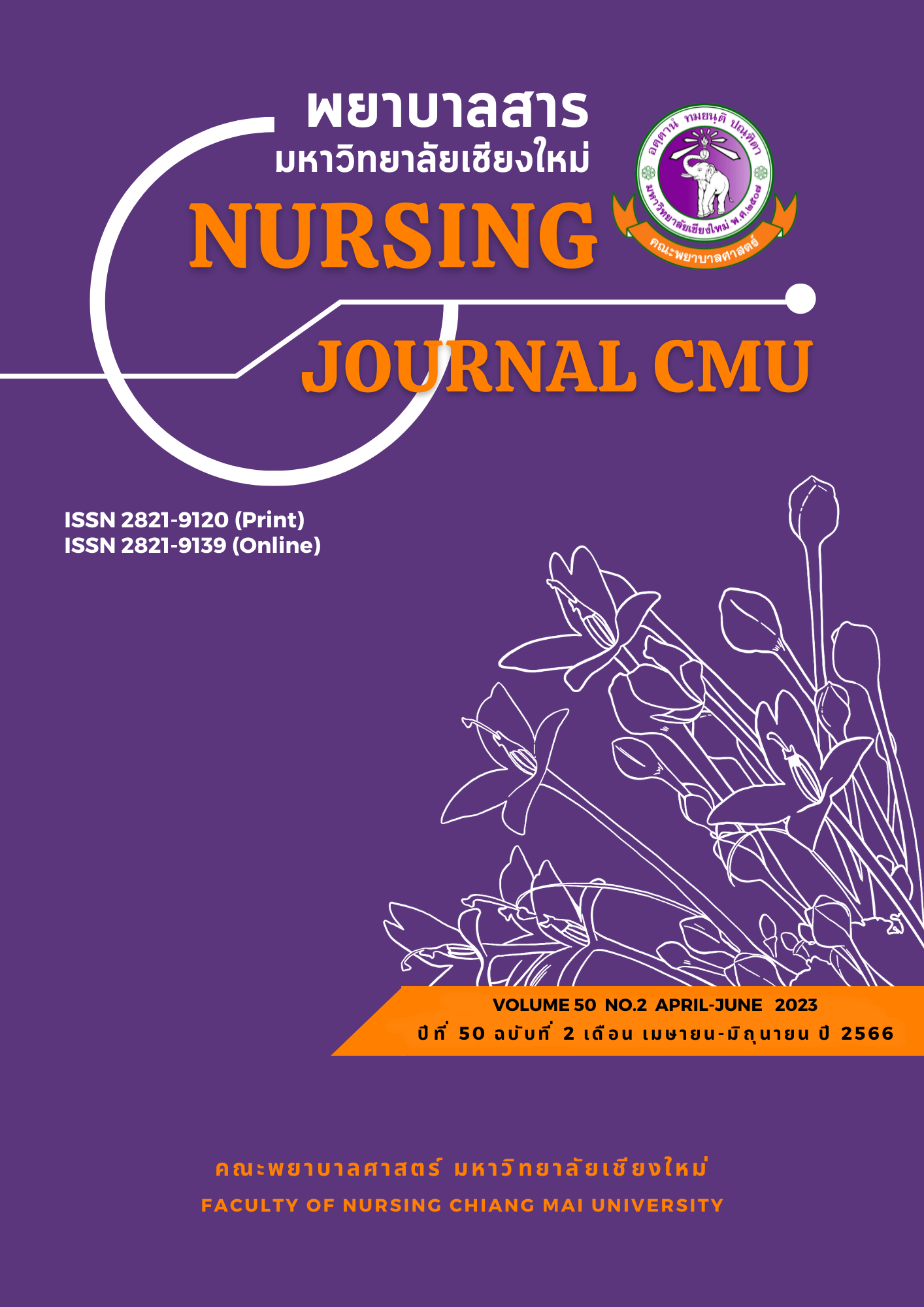Food Literacy and Consumption Behavior Among Dependent Elders
Keywords:
Food literacy, Consumption behavior, Dependent eldersAbstract
Older persons with dependency who have good food literacy will be able to manage their consumption behavior. This descriptive correlational research aimed to determine the relationship between the food literacy and food consumption behavior in dependent elders. The sample comprised 88 dependent elders residing in Mae Wang district in Chiang Mai province. The data collection period was between July and September 2021. Purposive sampling was used. The tools for data collection were a demographic and illness information questionnaire, a food literacy questionnaire, and a questionnaire on dietary behavior of dependent elders. The quality of the instruments was tested using content validity and test-retest reliability. Data were analyzed using descriptive statistics and Pearson’s product-moment correlation statistics.
The study revealed that the food literacy and consumption behavior of dependent elders were at a moderate level. Food literacy was moderate, and it was positively related to consumption behavior (r = .32, p < .001).
The findings of this study can be applied as basic information for health personnel planning about promoting consumption behavior in dependent elders.
References
Aekplakorn, W., Puckcharern, H., & Satheannoppakao, W. (2021). The 6th survey of Thai public health by physical examination 2019-2020. Bangkok: Mahidol University.
Bernhardt, N. E., & Kasko, A. M. (2008). Nutrition for the middle aged and elderly. New York: Nova Biomedical Books.
Brennan, D., Singh, K., Liu, P., & Spencer, A. (2010). Fruit and vegetable consumption among older adults by tooth loss and socio-economic status. Australian Dental Journal, 55(2), 143-149.
Chaitokkia, S. (2015). Factors affecting food consumption behaviors of adults in Northeastern Thailand. Loei: Loei Rajabhat University.
Chauhan, S., Kumar, S., Bharti, R., & Patal, R. (2022). Prevalence and determinants of activity of daily living and instrumental activity of daily living among elderly in India. BMC Geriatrics, 22, 64. doi: 10.1186/s12877-021-02659-z
Chitaphankul, S. (2001). Principles of geriatric medicine (3rd ed.). Bangkok: Chulalongkorn University Printing House.
Department of Medical Services. (2014). Screening/Assessment manual for the elderly. Nonthaburi: Office of the Veterans Organization. (in Thai)
Department of Health Service Support. (2021). Mae Wang District data report. Retrieved from https://3doctor.hss.moph.go.th/ (in Thai)
Duangina, T., Panuthai, S., & Suwankruhasn, N. (2020). Food consumption behaviors and nutritional status in dependent older persons. Nursing Journal, 47(1), 231-241. (in Thai)
Green, L., & Kreuter, M. (1999). The precede–proceed model. In health promotion planning: An educational approach (3rd ed., pp. 32-43.) Mountain View, CA: Mayfield Publishing.
Jirojkul, P. (2005). Nursing research, philosophy, principles and practices (2nd ed.). Bangkok: Academic Welfare Project, Praboromarajchanok Institute. (in Thai)
Julsukon, A., Piaseu, N., Thipsuwannakool, V., & Lininger, J. (2019). Nutrition literacy and health outcomes in older adults with type 2 diabetes. Thai Journal of Nursing Council, 34(4), 120-135. (in Thai)
Kaeodumkoeng, K., & Thummakul, D. (2015). Health literacy promoting in aging population. Journal of Health Science Research, 9(2), 1-8. (in Thai)
Kahn, R. L., Goldfarb, A. I., Pollack, M., & Peck, A. (1960). Brief objective measures for the determination of mental status in the aged. American Journal of Psychiatry, 117(4), 326-328.
Kingkaew, W. M. (2012). Factors related to eating behavior of the elderly Samut Songkhram Province. Bangkok: Suan Sunandha Rajabhat University. (in Thai)
Krause, C., Sommerhalder, K., Beer-Borst, S., & Abel, T. (2018). Just a subtle difference? Findings from a systematic review on definitions of nutrition literacy and food literacy. Health Promotion International, 33(3), 378-389.
National Statistical Office Thailand. (2022). Demographic statistics population and housing. Retrieved form http://statbbi.nso.go.th/staticreport/page/sector/th/01.aspx
Oti, J. A., & Eshun, G. (2020). Dietary habits and nutritional status of undergraduate students of Winneba campus of University of education, Winneba, Ghana. Journal of Food Science and Nutrition, 2020, 109. doi: 10.46715/jfsn2020.10.1000109
Pantha, A. (2009). Food consumption and nutritional status of the elderly (Unpublished master’s thesis). Chiang Mai University, Thailand. (in Thai)
Panuthai, S., Codrington, S., Duangjina, T., & Tosanguan, R. (2023). Food literacy and eating behaviors among Chiang Mai University personnel. Nursing Journal CMU, 50(1), 55-67. (in Thai)
Polit, D. F., & Beck, C. T. (2016). Nursing research: Generating and assessing evidence for nursing practice (10th ed.). Baltimore: Lippincott Williams & Wilkins.
Prayoonwong, N. (2022). Trend situation and health promotion of elderly bedridden people in Thailand. Journal of Public Health and Innovation, 2(2), 14-25. (in Thai)
Pruksa, S. (2016). Factors affecting food consumption behaviors of elderly in Northeast Thailand. Nonthaburi: Ministry of Public Health.
Ringland, E. M., Gifford, J. A., Denyer, G. S., Thai, D., Franklin, J. L., Stevenson, M. M., … O’Connor, H. T. (2016). Evaluation of an electronic tool to assess food label literacy in adult Australians: A pilot study. Nutrition and Dietetics, 73(5), 482-489.
Tamthong, K. (2003). Factors affecting the elderly's nutrition: A case study in Thachang Viliage, Ban Lat District, Petchaburi Province (Master’s thesis). Chulalongkorn University, Thailand. (in Thai)
Taylor, M. K., Sullivan, D. K., Ellerbeck, E. F., Gajewski, B. J., & Gibbs, H. D. (2019). Nutrition literacy predicts adherence to healthy/unhealthy diet patterns in adults with a nutrition-related chronic condition. Public Health Nutrition, 22(12), 2157-2169.
Thunthisirin, K., & Yamborisuth, A. (2018). Nutrition and health in the elderly. Retrieved from http://advisor.anamai.moph.go.th/main.php?filename=JHealthVol20No2_03 (in Thai)
Vaivong, K. (2021). Nutrition literacy of elderly people in region health 2 under the COVID-19 epidemic. Thailand Journal of Health Promotion and Environmental Health, 44(3), 51-64.
Vidgen, H. A., & Gallegos, D. (2014). Defining food literacy and its components. Appetite, 76, 50-59. doi: 10.1016/j.appet.2014.01.010
World Health Organization. (2021). WHO global sodium benchmarks for different food categories. Retrieved from https://www.who.int/publications/i/item/9789240025097
Yarmohammadi, P., Morowatisharifabad, M. A., Rahaei, Z., Khayyatzadeh, S. S., & Madadizadeh, F. (2022). Nutrition literacy and its related demographic factors among workers of Taraz steel company, Chaharmahal and Bakhtiari, Iran. Frontiers Public Health, 10, 911619. doi: 10.3389/fpubh.2022.911619
Downloads
Published
How to Cite
Issue
Section
License
Copyright (c) 2023 Nursing Journal

This work is licensed under a Creative Commons Attribution-NonCommercial-NoDerivatives 4.0 International License.
บทความที่ได้รับการตีพิมพ์เป็นลิขสิทธิ์ของวารสารพยาบาลสาร
ข้อความที่ปรากฏในบทความแต่ละเรื่องในวารสารวิชาการเล่มนี้เป็นความคิดเห็นส่วนตัวของผู้เขียนแต่ละท่านไม่เกี่ยวข้องกับมหาวิทยาลัยเชียงใหม่ และคณาจารย์ท่านอื่นๆในมหาวิทยาลัยฯ แต่อย่างใด ความรับผิดชอบองค์ประกอบทั้งหมดของบทความแต่ละเรื่องเป็นของผู้เขียนแต่ละท่าน หากมีความผิดพลาดใด ๆ ผู้เขียนแต่ละท่านจะรับผิดชอบบทความของตนเองแต่ผู้เดียว






